7.6 /10 1 Votes
4/5 Google Play Release date(s) NA: June 19, 1983 Initial release date 19 June 1983 | 7/10 Steam Composer(s) Chris Stone Cabinet Upright Genre Interactive movie | |||||||||||||||||||||||||||||||||
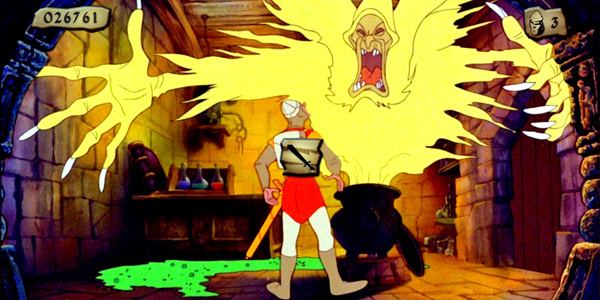 | ||||||||||||||||||||||||||||||||||
Mode(s) Up to 2 players (alternating turns) Developers RDI Video Systems, Digital Leisure, Starcom, Encore, Inc., Backbone Entertainment, ReadySoft, MMJ Games Similar Dragon's Lair games, Digital Leisure games, Interactive movie games | ||||||||||||||||||||||||||||||||||
Dragon's Lair is a laserdisc video game published by Cinematronics in 1983 as the first game in the Dragon's Lair series. In the game, the protagonist Dirk the Daring is a knight attempting to rescue Princess Daphne from the evil dragon Singe who has locked the princess in the foul wizard Mordroc's castle. It featured animation by ex-Disney animator Don Bluth.
Contents
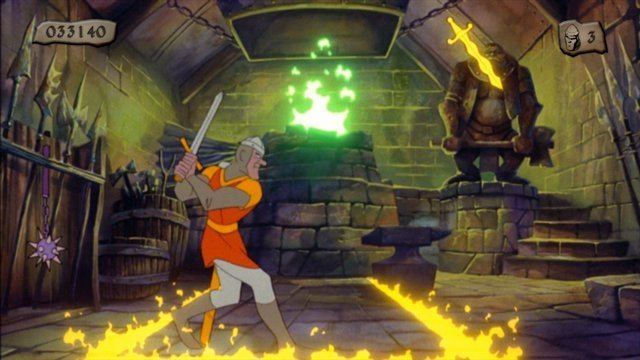
Most other games of the era represented the character as a sprite, which consisted of a series of pixels displayed in succession. Due to hardware limitations of the era, artists were greatly restricted in the detail they could achieve using that technique; the resolution, framerate and number of frames were severely constrained. Dragon's Lair overcame those limitations by tapping into the vast storage potential of the LaserDisc, but imposed other limitations on the actual gameplay.
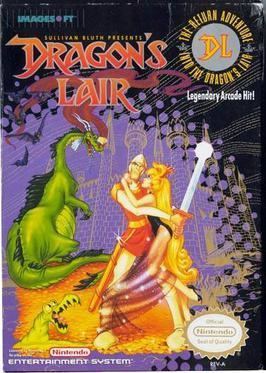
The success of the game sparked numerous home ports, sequels and related games. In the 21st century it has been repackaged in a number of formats (such as for the iPhone) as a "retro" or historic game.
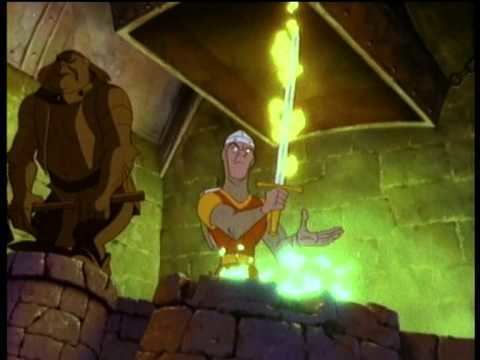
Gameplay
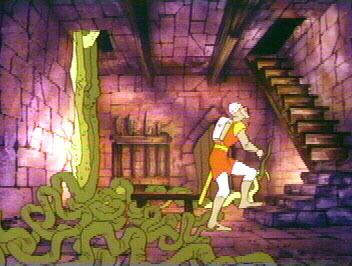
The game displays animated cutscenes, and the player executes an action by selecting a direction or pressing the sword button with correct timing in order to clear each quick time event (QTE). The comedy aspects of the game stemmed not only from the bizarre-looking creatures and humorous death scenes, but also the fact that the player character was somewhat clumsy in his efforts, as well as being a reluctant hero, prone to shrieking and reacting in horror to the various dangers he encounters. Instead of controlling the character's actions directly, players control his reflexes, with different full motion video (FMV) segments playing for correct or incorrect choices. While there are a limited number of scenes, other than the first and last, these are played in a random order. Some scenes are played more than once before reaching the end and additionally some scenes are flipped or mirrored such that the opposite actions (e.g. left instead of right) are required.
Plot
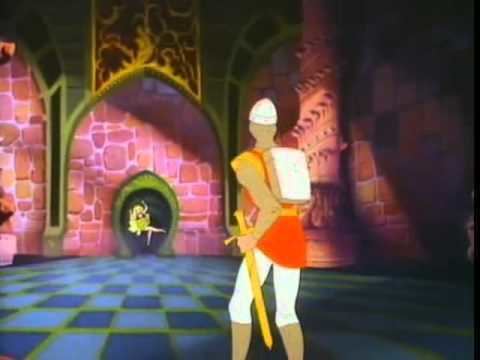
The attract mode of the game displays various short vignettes of gameplay accompanied by the following narration: "Dragon's Lair: The fantasy adventure where you become a valiant knight, on a quest to rescue the fair princess from the clutches of an evil dragon. You control the actions of a daring adventurer, finding his way through the castle of a dark wizard, who has enchanted it with treacherous monsters and obstacles. In the mysterious caverns below the castle, your odyssey continues against the awesome forces that oppose your efforts to reach the Dragon's Lair. Lead on, adventurer. Your quest awaits!"
Development
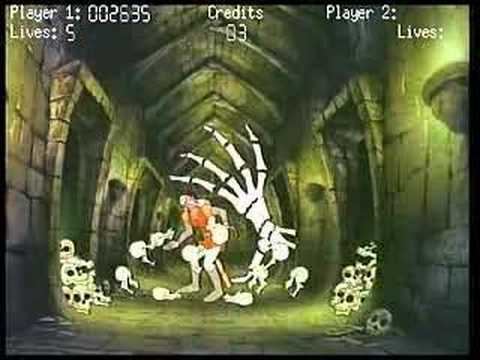
Dragon's Lair began as a concept by Rick Dyer, president of Advanced Microcomputer Systems (which later became RDI Video Systems). A team of game designers created the characters and locations, then choreographed Dirk's movements as he encountered the monsters and obstacles in the castle. The art department at AMS created storyboards for each episode as a guide for the final animation. Dyer was inspired by the text game Adventure. This game gave rise to an invention he dubbed "The Fantasy Machine". This device went through many incarnations from a rudimentary computer using paper tape (with illustrations and text) to a system that manipulated a videodisc containing mostly still images and narration. The game it played was a graphic adventure called The Secrets of the Lost Woods. Attempts to market The Fantasy Machine had repeatedly failed. Allegedly, an Ideal Toy Company representative walked out in the middle of one presentation. Dyer's inspiration allegedly came during his viewing of The Secret of NIMH, whereby he realized he needed quality animation and an action script to bring excitement to his game. He elected to take a reserved but unscripted location from The Secrets of the Lost Woods known as The Dragon's Lair.
The game was animated by veteran Disney animator Don Bluth and his studio. Development was done on a shoestring budget, cost US$1 million and took seven months to complete. Since the studio couldn't afford to hire any models, the animators used photos from Playboy magazines for inspiration for the character Princess Daphne. The animators also used their own voices for all the characters instead of hiring voice actors in order to keep costs down, although it does feature one professional voice actor, Michael Rye, as the narrator in the attract sequence (he is also the narrator for Space Ace and Dragon's Lair II). The voice of Princess Daphne was portrayed by Vera Lanpher who was head of the Clean-up Department at the time. Dirk the Daring's voice belongs to film editor Dan Molina, who later went on to perform the bubbling sound effects for another animated character, Fish Out of Water, from 2005's Disney film Chicken Little, which he also edited. Dirk shrieks or makes other noises on numerous occasions but speaks words only twice. First, he mutters "Uh, oh" when the platform begins to recede during the fire-swinging sequence, then he exclaims "Wow!" when first entering the Dragon's Lair and laying eyes on the slumbering Princess Daphne. The music and many sound effects were scored and performed by Chris Stone at EFX Systems in Burbank. Bryan Rusenko and Glen Berkovitz were the recording engineers. The 43 second "Attract Loop" was recorded in a straight 18-hour session. Featured instruments, all keyboards, were the E-mu Emulator and Memory MOOG.
The original laserdisc players shipped with the game (Pioneer LD-V1000 or PR-7820) often failed. Although the players were of good quality, the game imposed unusually high strain: Laserdisc players were designed primarily for playing movies, in which the laser assembly would gradually move across the disc as the data was read linearly. However, Dragon's Lair required seeking different animation sequences on the disc every few seconds—indeed, less than a second in some cases—as dictated by gameplay. The high amount of seeking, coupled with the length of time the unit was required to operate, could result in failure of the laserdisc player after a relatively short time. This was compounded by the game's popularity. As a result, the laserdisc player often had to be repaired or replaced. The life of the original player's gas laser was about 650 hours; although later models had solid state lasers with an estimated life of 50,000 hours, the spindle motor typically failed long before that. It is rare to find a Dragon's Lair game intact with the original player, and conversion kits have been developed so the units can use more modern players. The original USA 1983 game used a single side NTSC laserdisc player manufactured by Pioneer; the other side of the disc was metal backed to prevent bending. The European versions of the game were manufactured by Atari under license and used single side PAL discs manufactured by Philips (not metal backed).
The European arcade version of Dragon's Lair was licensed to Atari Ireland (as was Space Ace later). The cabinet design was therefore different from the Cinematronics version. The main differences were that the LED digital scoring panel was replaced with an on screen scoring display appearing after each level. The Atari branding was present in various places on the machine (marquee, coin slots, control panel and speaker grill area), and the machines featured the cone LED player start button used extensively on Atari machines. Although licensing for this region was exclusive to Atari, a number of Cinematronics machines were also available from suppliers mostly via a gray import. The original Fantasy Machine was later released as a prototype video game console known as Halcyon.
Reception
Dragon's Lair initially represented high hopes for the then-sagging arcade industry, fronting the new wave of immersive laser disc video games. A quote from Newsweek captures the level of excitement displayed over the game: "Dragon's Lair is this summer's hottest new toy: the first arcade game in the United States with a movie-quality image to go along with the action... The game has been devouring kids' coins at top speed since it appeared early in July. Said Robert Romano, 10, who waited all day in the crush at Castle Park without getting to play, 'It's the most awesome game I've ever seen in my life.'" Arcade operators at its release reported long lines, even though the game was the first video arcade game to cost 50 cents. Operators were also concerned, however, that players would figure out its unique predefined game play, leading them to "get the hang of it and stop playing it." By July 1983, 1000 machines had been distributed, and there were already a backlog of about 7,500. By the end of 1983 Electronic Games and Electronic Fun were rating Dragon's Lair as the number one video arcade game in USA, while the arcade industry gave it recognition for helping turn around its 1983 financial slump. Dragon's Lair received recognition as the most influential game of 1983, to the point that regular computer graphics looked "rather elementary compared to top-quality animation". By February 1984, it was reported to have grossed over $32 million for Cinematronics. One element of the game that was negatively received was the blackout time in between loading of scenes, which Dyer promised would be eliminated by the forthcoming Space Ace and planned Dragon's Lair sequel. By the middle of 1984, however, after Space Ace and other similar games were released to little success, sentiment on Dragon's Lair's position in the industry had shifted and it was being cited as a failure due to its expensive cost for a game that would "lose popularity". Arcade owners were also displeased with the mechanical unreliability of the laserdisc drive.
The Commodore 64/128 version of the game was reviewed in 1988 in Dragon #133 by Hartley, Patricia, and Kirk Lesser in "The Role of Computers" column. The reviewers gave the game 3 out of 5 stars. GamePro reviewed the Sega CD version in 1994. They commented that the controls require such precise timing that the game can be very frustrating, and criticized the lack of replay value and grainy video quality, but were positive in their assessment of the game, asserting that "Time Gal, Road Avenger, and Sewer Shark are all coy imitators of the best laser-disc arcade game there ever was... Dragon's Lair!" In 1994 Electronic Gaming Monthly gave the Sega CD version a 6.2 out of 10, criticizing that "pinpoint accuracy" was required to complete the game, making it too frustrating. They gave the 3DO version a 7 out of 10, praising the superior graphics and short load times. They gave the CD-i version a 7.5 out of 10, with all four of their reviewers agreeing it to be the best home version of the game to date.
In 2001, GameSpy ranked Dragon's Lair as number 7 on the list of "Top 50 Arcade Games of All-Time". It was one of only three video games (along with Pong and Pac-Man) put in storage at the Smithsonian Institution.
Home versions
Various home computer adaptations of Dragon's Lair were released during the 1980s and 1990s but because of (at the time) high memory consumption due to the detailed animation of the games, not all the scenes from the original game were included. Reviewers of the home computer versions differed widely in their appraisal of the game, with one Amiga magazine awarding 92% due to the unprecedented audio-visual quality, while another magazine gave the same version a score of only 32% on account of the "wooden" gameplay. This led to Escape from Singe's Castle, a pseudo-sequel where Daphne is kidnapped at the moment of Dirk's victory by a shapeshifter, forcing him to venture even further into the castle to save her again. The game was made up of unused scenes from the laserdisc version, though some portions (such as the lizard king and mud men) were shortened. The 8-bit versions were created by Software Projects, while Readysoft handled the 16-bit versions. These used video compression and new storage techniques, but came on multiple 3.5" floppy disks.
In late 2002, to commemorate the 20th anniversary of the original arcade release, Digital Leisure Inc. produced a special edition DVD box set containing Dragon’s Lair, Space Ace and Dragon’s Lair II: Time Warp. All the scenes from the original arcade releases were included and optionally the player could select new scenes that were animated in 1983, but not included in any previous Dragon’s Lair release. The games were also updated to include higher quality video, authentic scene order and a new difficulty selection to make it more challenging. Digital Leisure worked with a small independent game developer, Derek Sweet, to release a CD-ROM 4-disc Box Set for Windows-based PCs.
In the late 2006, Digital Leisure released "Dragon's Lair HD", which features an all-new High-Definition transfer from the original negatives (as opposed to just sourcing the laserdisc). The original mono soundtrack has also been remastered into Dolby Digital 5.1 sound (on PCs that can support it). On April 9, 2007, a Blu-ray version of Dragon's Lair was released. This uses the same HD transfer as the aforementioned PC release, but went through a 6-month process to clean and remaster the image. Dragon's Lair Blu-ray is the first title to fully utilize BD-J technology. In 2013, Dragon's Lair was released on Steam via Steam Greenlight. This iteration of Dragon's Lair features 720p remastered video, remastered game footage, and bonus content.
Dragon's Lair led to the creation of numerous video game ports for home systems. Since some original sequences did not fit in the ports for those systems, they were re-released only in a virtual sequel called Escape from Singe's Castle:
